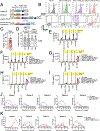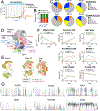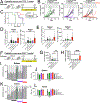Cooperative Armoring of CAR and TCR T Cells by T Cell-Restricted IL15 and IL21 Universally Enhances Solid Tumor Efficacy
- PMID: 37910044
- PMCID: PMC11018485
- DOI: 10.1158/1078-0432.CCR-23-1872
Cooperative Armoring of CAR and TCR T Cells by T Cell-Restricted IL15 and IL21 Universally Enhances Solid Tumor Efficacy
Abstract
Purpose: Chimeric antigen receptor (CAR) and T-cell receptor (TCR) T-cell therapies are effective in a subset of patients with solid tumors, but new approaches are needed to universally improve patient outcomes. Here, we developed a technology to leverage the cooperative effects of IL15 and IL21, two common cytokine-receptor gamma chain family members with distinct, pleiotropic effects on T cells and other lymphocytes, to enhance the efficacy of adoptive T cells.
Experimental design: We designed vectors that induce the constitutive expression of either membrane-tethered IL15, IL21, or IL15/IL21. We used clinically relevant preclinical models of transgenic CARs and TCRs against pediatric and adult solid tumors to determine the effect of the membrane-tethered cytokines on engineered T cells for human administration.
Results: We found that self-delivery of these cytokines by CAR or TCR T cells prevents functional exhaustion by repeated stimulation and limits the emergence of dysfunctional natural killer (NK)-like T cells. Across different preclinical murine solid tumor models, we observed enhanced regression with each individual cytokine but the greatest antitumor efficacy when T cells were armored with both.
Conclusions: The coexpression of membrane-tethered IL15 and IL21 represents a technology to enhance the resilience and function of engineered T cells against solid tumors and could be applicable to multiple therapy platforms and diseases. See related commentary by Ruffin et al., p. 1431.
©2023 American Association for Cancer Research.
Conflict of interest statement
Benjamin Y. Jin and Christian S. Hinrichs have an NIH patent related to the IL-15/IL-21 technology pending, licensed, and with royalties paid (Iovance Biotherapeutics). Christian S. Hinrichs disclosed multiple NIH patents in cell therapy and immunotherapy pending, issued, licensed, and with royalties paid (multiple companies).
Figures





References
MeSH terms
Substances
Grants and funding
LinkOut - more resources
Full Text Sources
Medical
Molecular Biology Databases

